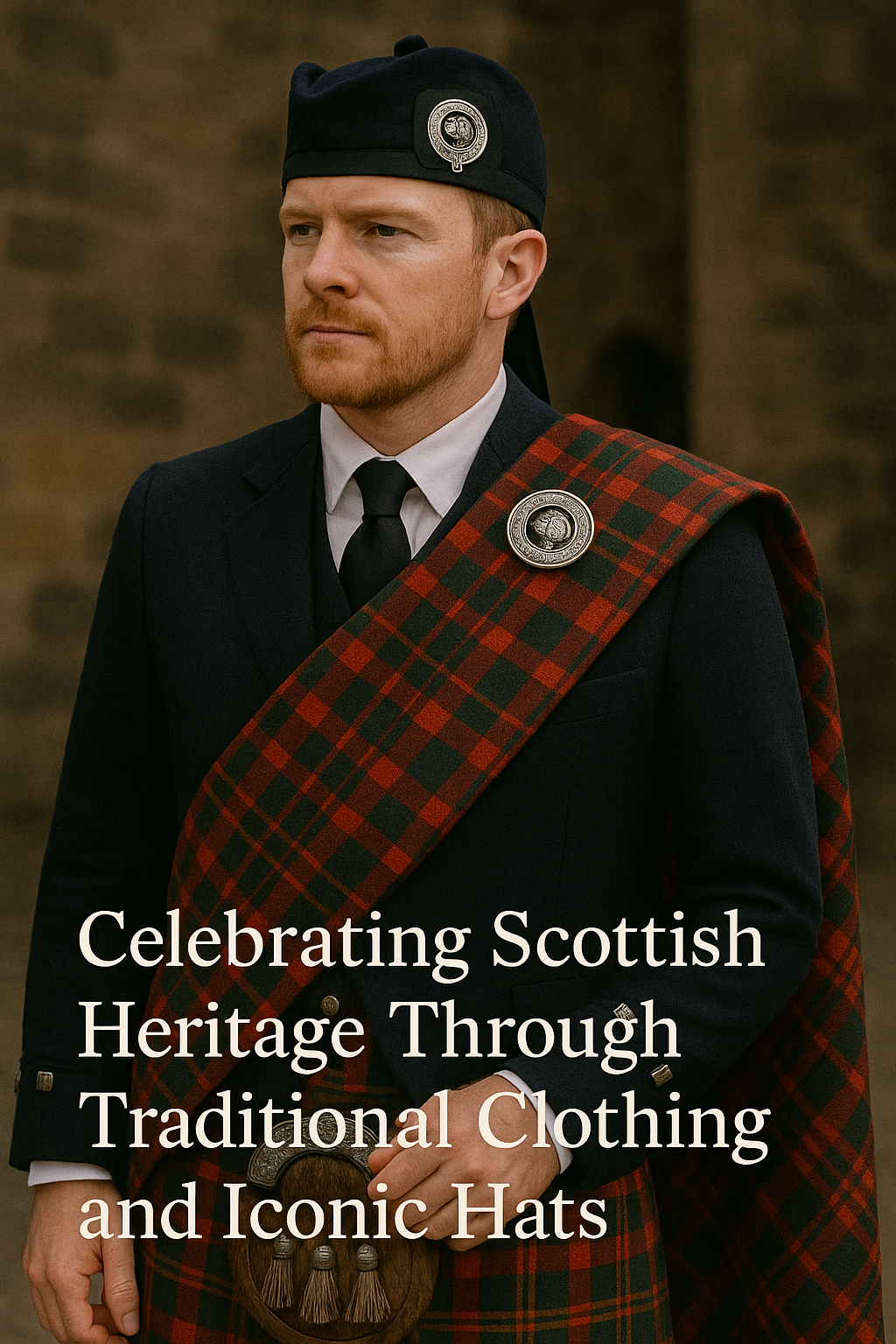
Celebrating Scottish Heritage Through Traditional Clothing and Iconic Hats
Published on Apr 20, 2025
Celebrating Scottish Heritage Through Traditional Clothing and Iconic Hats
introduction
Scotland is a land known for its majestic landscapes, proud clans, and deeply rooted traditions. At the heart of this cultural identity is its unique and instantly recognizable attire. From the bold patterns of tartans to the timeless charm of Scottish hats, the country’s clothing speaks volumes about its history and heritage.
In this article, we’ll explore Scotland’s traditional clothing, highlight the significance of its iconic headwear, and appreciate how these styles continue to honor a centuries-old legacy.
The Backbone of Scottish Fashion: Kilts and Tartans
No discussion of Scottish traditional clothing is complete without mention of the kilt. Known globally as the national dress of Scotland, the kilt is more than just a garment — it’s a cultural symbol. Traditionally made from woolen cloth with a distinctive tartan pattern, kilts originated in the Highlands during the 16th century.
Each tartan design, with its intersecting stripes of various colors, is unique to a Scottish clan, region, or family. Wearing a specific tartan was historically a way of showing loyalty and belonging. Even today, many Scots proudly wear their family’s tartan during special occasions, such as weddings or Highland Games.
But kilts are only one part of the picture. Traditional Highland dress also includes accessories such as the sporran (a pouch worn at the front), kilt hose (socks), ghillie brogues (lace-up shoes), and of course — the hats.
What Are Scottish Clothes Called?
Traditional Scottish attire for men typically includes the full Highland dress, comprising a kilt, shirt, waistcoat, jacket, sporran, belt, socks, and hat. For women, Scottish clothing often involves a tartan skirt or arisaid (a traditional cloak), with a matching sash worn over the shoulder and secured with a brooch.
These outfits are not worn every day in modern Scotland, but they are proudly displayed during cultural festivals, formal events, and clan gatherings. The clothing symbolizes a proud link to ancestry, culture, and the spirit of the Highlands.
Scottish Hats: A Distinctive Symbol of Culture
Beyond kilts and tartans, Scottish hats carry their own legacy and symbolism. Often overlooked, they’re an essential part of Highland dress and Scottish military uniforms. They also provide insight into Scottish identity, regional pride, and military history.
Here are the most iconic traditional Scottish hats:
Glengarry Bonnet
The Glengarry is a military-style cap made from thick wool, typically shaped like a boat with a crease along the top. Originating in the late 18th century, this hat is often worn tilted to one side and includes hanging ribbons at the back, along with a decorative toorie (pom-pom).
It has long been associated with Highland regiments and is still worn today as part of formal Scottish military dress and Highland attire.
Balmoral Bonnet
The Balmoral is a round, soft hat with a flat crown and a toorie in the center. It evolved from the blue bonnet of the 16th century and takes its name from Balmoral Castle. The Balmoral can be decorated with a rosette cockade or a clan badge.
Unlike the Glengarry, the Balmoral has a more casual appearance and is often worn slightly tilted, giving it an elegant but traditional look. It’s a popular choice for those wishing to wear authentic Scottish dress without the formal rigidity of military styles.
Tam o’ Shanter
Affectionately called the “tam,” this bonnet gets its name from the character in Robert Burns' poem Tam o’ Shanter. It’s a wide, flat hat with a single pom-pom in the center, often made from wool and worn more casually than its counterparts.
Originally worn by working-class Scots, the tam became a unisex fashion item and remains a cherished piece of Scottish headwear today.
Scotland Traditional Attire Today
While modern fashion has evolved, traditional Scottish clothing remains deeply valued. Many Scots continue to don Highland dress on ceremonial occasions, including national holidays like St. Andrew’s Day and Burns Night. Additionally, cultural events like ceilidhs (social dances) and Highland Games keep these traditions alive and well.
Traditional clothing, especially kilts and hats, is also worn at family gatherings, graduations, and international Scottish festivals. Beyond Scotland’s borders, many descendants of Scottish immigrants embrace their roots by wearing tartans and Scottish hats with pride.
Scottish Heritage in Modern Fashion
Interestingly, elements of Scottish clothing have crossed over into mainstream fashion. Designers have repeatedly drawn inspiration from tartan patterns, incorporating them into everything from high-end couture to streetwear. Kilts, once seen only in traditional settings, are now worn in modern variations by people across the globe.
Even Scottish hats have influenced broader headwear styles, with the tam o’ shanter evolving into modern berets and flat caps. This seamless blend of tradition and modernity proves that Scottish heritage has staying power in the world of style.
The Role of Traditional Clothing in Preserving Heritage
Scottish traditional clothing is more than just fabric and design. It's a tangible way to connect with history, celebrate identity, and honor the stories of those who came before. Whether it’s the symbolic lines of a family tartan or the distinct silhouette of a Glengarry bonnet, each item has meaning.
Preserving this clothing tradition is a way of keeping Scottish culture alive. Artisans, tailors, and hat makers continue to craft these garments with care, ensuring authenticity in both design and purpose.
Final Thoughts
Scotland’s traditional clothing, from kilts and tartans to its iconic hats, offers a vivid expression of national pride and historical legacy. These garments not only define a unique cultural aesthetic but also represent strength, identity, and timeless tradition.
Wearing a piece of Scottish heritage—whether a tartan scarf, a Glengarry bonnet, or a full Highland dress—is a celebration of a proud and enduring culture. It’s a tradition that continues to inspire people in Scotland and around the world.
